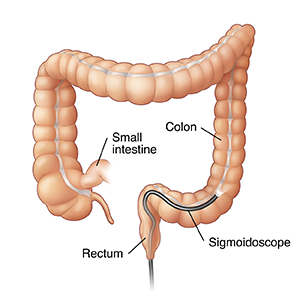When Your Child Needs a Colonoscopy or Sigmoidoscopy
A colonoscopy is a test that lets a healthcare provider look inside the colon and rectum. A sigmoidoscopy is a shorter form of this test. It looks at only the lower part of the colon (the sigmoid colon) and the rectum. The provider may take tissue samples (biopsy). They may also check for growths (polyps) or bleeding. The time needed for the test will depend on how clean the colon is, what the health problem is, and if treatment is needed. Colonoscopy takes about 30 minutes. Sigmoidoscopy takes about 10 to 15 minutes.
 |
| A colonoscope gives the doctor an inside view of the entire colon. |
 |
| A sigmoidoscope gives the doctor an inside view of the sigmoid colon. |
Before the test
Your child’s colon may need to be cleaned out before the test. Follow any instructions from the healthcare provider. You may need to:
-
Have your child drink a liquid bowel prep before the test
-
Switch your child to a clear liquid diet 1 to 2 days before the test
-
Give your child a laxative, a suppository, or enema the night before and on the day of the test
Tell the healthcare provider...
For your child’s safety, tell the healthcare provider if your child:
-
Has an allergy to any medicine, sedative, or anesthesia
-
Has a heart or lung problem
-
Takes any medicines, including over-the-counter medicines, vitamins, herbs, and other supplements
During the test
A colonoscopy or sigmoidoscopy is done by a healthcare provider in an office, testing center, or hospital.
-
You can stay with your child in the testing room until your child falls asleep or the test starts.
-
Your child lies on an exam table on his or her left side.
-
Your child is given a pain reliever and medicine that makes your child sleepy (sedative). This is done through an IV line. Or your child is given medicine that makes your child sleep (anesthesia) by face mask or IV. A trained nurse or anesthesiologist helps with this process and also monitors your child. Special equipment is used to check your child’s heart rate, blood pressure, and blood oxygen levels. Sigmoidoscopy often doesn’t require your child to be sedated.
-
The healthcare provider inserts a colonoscope or sigmoidoscope into your child’s rectum and colon. This is a long, flexible tube with a camera and a light at the end. During a sigmoidoscopy, the scope will only move through the sigmoid colon. It will sometimes travel a bit farther if the view is clear and the child is comfortable.
-
Air is pushed through the scope to expand your child’s lower gastrointestinal (GI) tract. Water may also be used to clean the colon.
-
Images of your child’s colon are viewed on a screen as the scope moves along.
-
The healthcare provider may take tissue samples. He or she may remove any polyps that are found.
After the test
When the test is done, you can expect the following:
-
If a sedative or anesthesia was given, your child is taken to a recovery room. It may take 1 to 2 hours for the medicine to wear off.
-
Your child can go back to his or her normal routine and diet right away, unless told otherwise.
-
The healthcare provider may discuss early results with you after the test. You’re given complete results when they’re ready.
Helping your child get ready
You can help your child by preparing in advance. How you do this depends on your child’s needs. Try the following:
-
Explain that the healthcare provider will be testing the colon and rectum. Use brief and simple terms to describe the test. Younger children have shorter attention spans, so do this shortly before the test. Older children can be given more time to understand the test in advance.
-
As best you can, describe how the test will feel. An IV may be inserted into the arm to give medicines. This may cause a little sting. Your child won’t feel anything once the medicines take effect.
-
If your child is not sedated, then mild cramping is common.
-
Allow your child to ask questions.
-
Use play when helpful. This can involve role-playing with a child’s favorite toy or object. It may help older children to see pictures of what happens during the test.
When to call the healthcare provider
Call the healthcare provider if your child has any of these:
-
Belly (abdominal) pain, upset stomach (nausea), or vomiting
-
A large amount of blood in their poop right after the test or blood in their poop for a few days
-
Lasting fever over 100.4°F (38.0°C), or as advised by the provider